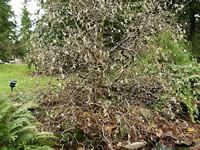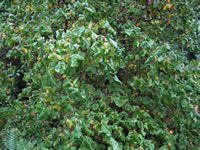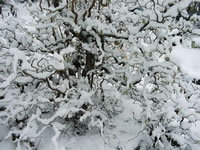How to Grow and Care for Harry Lauder's Walking Stick
Corylus avellana 'Contorta'
        
|

|
Harry Lauder's Walking Stick was first discovered growing in an English hedgerow in the mid-1800s. This slow growing, deciduous, multi-stemmed shrub typically grows to 8-10 ft. tall and 6-8 ft. wide. In late winter or early spring, before the foliage emerges, the Contorted Filbert will begin to cover itself
with monoecious (separate male and female flowers on the same plant) flowers. The female flowers are barely noticeable, and the 2-3" long, yellowish brown catkins that hold the male flowers are less than spectacular.
By mid spring, the entire tree will become enveloped in softly crinkled, green or burgundy, 4" leaves,
creating a lush focal point for any garden.
In the fall, the foliage slowly changes to a golden yellow before dropping.
Only then, will you discover the true inner beauty of Harry Lauder's Walking Stick...
The fantastically twisted, gnarled, contorted, spiraling branches of this Corkscrew Hazelnut
will quickly capture your imagination. Plant it where you can enjoy the silhouette of the curiously twisted branches against the snow or other backdrop.
|
|
Harry Lauder's Walking Stick is easy to grow and well suited for growing in large outdoor planters.
Their twisted branches are often used by florists in flower arrangements.
Growing Requirements for Contorted Filberts
Contorted Filberts are hardy in zones 3-9.
Corylus should be grown in full sun, but they will tolerate partial shade as well.
They will tolerate dry soils but will grow best when planted in loamy, well-drained soils with acidic to slightly alkaline (6.5-7.7) soil pH.
Once established, Harry Lauder's Walking Sticks are fairly drought tolerant trees, but should be watered regularly during periods of extreme heat.
Feed with a Rhododendron type fertilizer every six weeks from April 1st until October 31st. Use ½ the recommended strength of fertilizer for new plantings.
The species, Corylus avellana is commonly grown for nut production but
the Corkscrew Hazelnut usually does not produce nuts. |
|
|
Pruning and Propagation of Contorted Filberts
The majority of Harry Lauder's Walking Sticks available at nurseries are grafted plants and require some special care.
As often happens with grafted plants, there is a tendency for suckers to shoot up from the rootstock.
You must prune off these suckers to prevent the plant from reverting to the characteristics of its rootstock.
I have had some limited success propagating Walking Sticks by layering the lower branch tips in the fall.
Layering is easily accomplished by pinning the stem onto the soil surface.
Roots will grow at each point where a node is in contact with the soil.
Once rooted, the new plant can be severed from the parent and replanted.
A faster method of propagation is to graft a branch from your Walking Stick onto the root stock of a Corylus colurna (Turkish Hazel) Tree during the winter months. |
Harry Lauder's Walking Stick
Corylus avellana 'Contorta'
 |
 |
 |
|
|
|
Search The Garden Helper:




